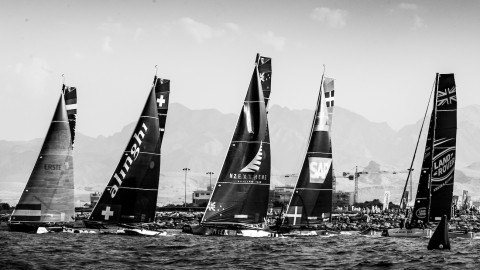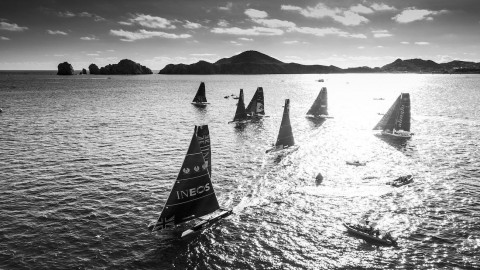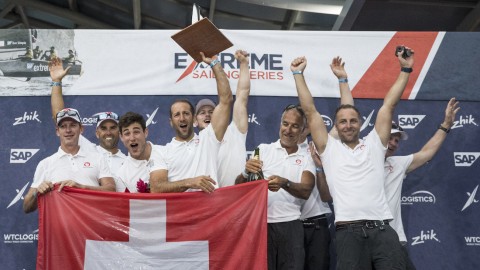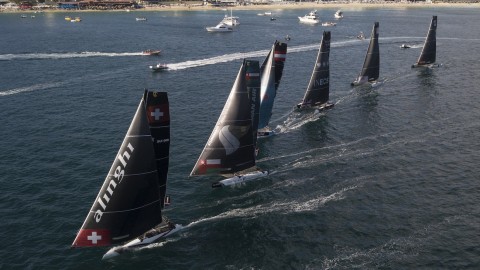Michael Hestbæk: Coaching the speed merchants in the Extreme Sailing Series™
Imagine racing a 32ft foiling catamaran at more than 30 knots on an inner city stadium racecourse with other boats “flying” on all sides. The boat is powering forward and the marks of the course are coming up so fast you barely have time to think about what will happen when you get round them – and your opponents are crossing or overtaking.
Tuesday 4th April 2017

by Ed Gorman
Imagine racing a 32ft foiling catamaran at more than 30 knots on an inner city stadium racecourse with other boats “flying” on all sides. The boat is powering forward and the marks of the course are coming up so fast you barely have time to think about what will happen when you get round them – and your opponents are crossing or overtaking.
In these high-intensity situations even the world’s best sailors need eyes in the backs of their heads. Full time coaches are there at every Act to try to help skippers and tacticians make the right tactical and strategic decisions while they are ripping up and down the racecourse in machines that behave more like small aeroplanes than boats.
The man who was in charge of the off-the-boat thinking in SAP Extreme Sailing Team’s 2016 campaign, and who will be working closely with the squad this season, is the Danish America’s Cup sailor Michael Hestbæk. An Olympic 49er and Star class sailor who loves to spend his free time kite surfing or hydro-foil kiting, Hestbæk brings a wealth of experience to the job.
Hestbæk worked out long ago that there is very little he can teach the SAP Extreme Sailing Team crew about boat-handling. The team led by Extreme Sailing Series™ veterans Jes Gram-Hansen and Rasmus Køstner know what they are doing in a GC32. Where Hestbæk‘s expertise comes in is in his ability to spot what is going on on the racecourse, where the best breeze is to be found, the best lanes to sail and the best tactical options to take. In each case these are the sorts of decisions that are exceptionally hard to get right when your main focus is keeping your super-powerful catamaran under control.
Hestbæk, aged 47 and from Copenhagen, is a cool customer and the ideal personality to help take the stress out of even the most dramatic situations. He says his role is to watch the day’s racing from his support boat – from what he calls a “helicopter” perspective – and try and help turn the bad days into decent ones.
“The hardest challenge, for sure, for Extreme Sailing Series crews is to handle the boat but all the top teams are good enough at that, so then the challenge is to sail the boat tactically while handling it,” he says. “That seems to be a struggle for most of the teams. For example a downwind leg in the breeze takes you only about 45 seconds in a GC32 so there is not much time to think about tactical manoeuvres and strategic positioning on the racecourse because you have your hands full just getting the boat down to the gate.”
Hestbæk says that before racing starts he looks at how the course is set up, how the breeze behaves in the corners and where it is lighter or stronger or where it might be more shifty. He also measures any tidal flow and watches the fleet practicing to get an idea of the best angles to sail on each leg. What he is looking for are trends in the behaviour of the wind and the water that he can pass on to the team on board.
“The easier regattas for me to help the team with have generally been the stadium racecourses (as opposed to more open settings or longer coastal courses) because often there is a pattern and there is an ideal lane that you can sail,” he says. “On a steady breeze day the pattern develops pretty quickly and I can probably pick it up quicker than the team because I’ve got nothing else to look at and I can watch all the boats. On those racecourses I can really make a difference.”
Before racing starts Hestbæk will brief the team on what he has found. He makes the point that the multiple race format in the Extreme Sailing Series – with up to nine races a day – means the coaches have plenty of opportunities to update their crews between races, compared to say a typical day in the Olympics when there might be only one or two races. Hestbæk tells the Danish team what he thinks but he admits they don’t always agree with him. “I will feed them all the information I have on the course set-up and what I imagine is the ideal lane to sail,” he says. “But they will have their own opinion and my input is just that – they can use some of it, but they may not use all of it.”
The other main role for the coach is to monitor each day’s sailing, filming some of it, and then chair the daily de-briefing before the crew take to the water again. In the case of SAP Extreme Sailing Team this de-briefing session usually happens in the morning each day before racing. Hestbæk says the data provided through the SAP Sailing Analytics programme, which has been developed to measure a wide variety of performance indicators on the GC32s in the Extreme Sailing Series, is an invaluable teaching aid.
“The analytics programme allows us to look at every race with technical data down to every second,” he says. “We can use the programme to see distance to a mark, distance to other boats, angles for tacking and gybing, plus the basics like boatspeed and heading and so on. Another very useful tool is one that tells me the lanes sailed by the top three boats in any race.
“The SAP Sailing Analytics programme is very useful for coaches,” adds Hestbæk. “If there is a question on what we did in a race – or what an opponent did – then you can go to the analytics because the data doesn’t lie – it will tell you exactly where you were and how you got into a situation or how you could have got out of it. When you are doing eight or nine races in a day, it is sometimes hard to remember all the details of any one race, so the programme is brilliant for that.”
Hestbæk started working with the SAP Extreme Sailing Team at the Singapore Act in 2014 and then helped the crew achieve second overall in 2015 – its best ever finish. Last year the team finished a tough opening year in the GC32 class in fourth place. The softly-spoken Dane thoroughly enjoys working with a team that, he says, always has a good vibe about it.
“The atmosphere and the spirit of the team is really great,” he says. “In order to get results and do well you need to have good camaraderie and a positive attitude. And we all have that in the team and because of that it’s really enjoyable to work with the guys.”




